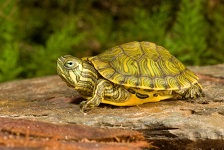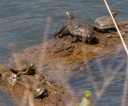Texas Cooter (Pseudemys texana)
Description: Texas river cooters possess narrow yellow head striping with spots and dashes. Their skin is black with yellow and white striping. A singular stripe curves around their jaw with a yellow spot behind the eye. Their brown carapace is flat in the middle and scored around the edge with fine yellow webbing and swirls for coloring. Their plastron has little, if any, pattern in older river cooters, but the rim may have a red tint. River cooters can become melanistic as they age. Male river cooters have a thicker tail and their vent is behind the carapacial rim. The carapacial rim is part of the carapace that covers the plastron. Female river cooters have shorter tails and their vent is anterior to the carapacial margin. Male river cooters have longer and more noticeable foreclaws than female cooters
The carapace on juveniles is the same brown color as adults. The pattern is lighter than adults with five or six obvious lighter yellow rings and swirls. The pattern will diffuse and texturize with age. The plastron is yellow with thin black lines on the edges.
Habitat: Texas river cooters are aquatic animals. They are normally found in the shallow water of freshwater rivers, but they can enter riverine pools as deep as 4m. River cooters have also been observed in lakes with sewage sludge. They can also inhibit riverine impoundments, nearby cattle tanks, canals, and irrigation ditches. River cooters are most commonly found in clear water with soft, dense vegetation beds or in wetlands near their permanent water source.
Range: It is found in the river basins of the Brazos, San Bernard, Colorado, Guadalupe, San Antonio, Nueces, and their tributaries.
Found in these States:
FL |
KS |
TX
Diet: Adult Texas river cooters of both sexes are primarily herbivorous when mature. The main plants in their diet are hydrilla (Hydrilla verticillata), Carolina fanwort (Cabomba caroliniana), parrot feather (Myriophyllum), common coontail (Ceratophyllum demersum), delta arrowhead (Sagitaria platphylla), cone-spur bladderwort (Utricularia gibba) and filamentous green algae (Chlorophyta). Fields et al. (2003) reported stomach contents of river cooters. They found parrot feather (Myriophyllum) was present in 90.9% of stomach samples, Hydrilla verticillata in 87.9%, Cabomba caroliniana in 78.8%, and Ceratophyllum demersum in 57.6%. In the stomach contents, 2.1% of their diet was unknown vegetation. Leaves from the plants are the most often consumed.
Juveniles have a more carnivorous diet than adult river cooters. Common prey eaten by juvenile river cooters includes freshwater sponges (family Spongillidae), aquatic insect larvae like mayflies, crayfish (order Decopoda), snails (order Gastropoda) and small freshwater clams
Reproduction: Female Texas river cooters use pheromones to attract potential mates. Mating begins in early spring in March and April. The males will sniff the females’ cloaca when looking for a mate. Males will shake their foreclaws and extend their forearms to attract female cooters. Texas river cooters are polygynandrous, meaning males and females have multiple partners in their lifetime.
Texas river cooters begin mating in early spring, in March and April. They nest from May until June. Gestation period for river cooters is estimated from 60 to 70 days. Female cooters lay between 0-3 (typically 1) clutches of 4-19 eggs during this period. Larger females lay larger clutches. Females have only been observed nesting diurnally. The process of leaving the water, ovipositing, and returning to the water takes the females 2.5-3 hours. August and September are when hatchlings will emerge. The eggs incubation period ranges from 80-150 days; this range can be affected by the amount of water and nest temperature. Birth mass is not reported but lengths at hatching are estimated: average plastron lengths of 1.3 inches for males, and 0.9 inches for females. These turtles are immediately independent at hatching. Male cooters are sexually mature at 3 years old, while females can take 6 or more years to mature.
Status: Texas river cooters are considered a species of “Least Concern” on the IUCN Red List. They have no special status on the US Federal List, CITES.
These freshwater turtles face habitat loss, degradation, and invasive species. Red imported fire ants (Solenopis invicta) are a direct threat to nesting cooters and their eggs. Fire ants can kill the hatchling or enter the egg through any impurities and kill them. Humans are also a threat to Texas river cooters. They are hunted for food and can also be hit by cars. There is no restriction on hunting.
»» Kingdom: Animalia - Animals
»» Phylum: Chordata - Chordates
»» Subphylum: Vertebrata - Vertebrates
»» Class: Reptilia - Reptiles
»» Order: Testudines - Turtles & Tortoises
»» Family: Emydidae - Pond, Marsh, & Box Turtles
»» Genus: Pseudemys
»» Species: Pseudemys texana - Texas Cooter
»» Subspecies: None
This article uses material from the Wikipedia article "Texas River Cooter", which is released under the Creative Commons Attribution-Share-Alike License 3.0. Content may have been omitted from the original, but no content has been changed or extended.
|








